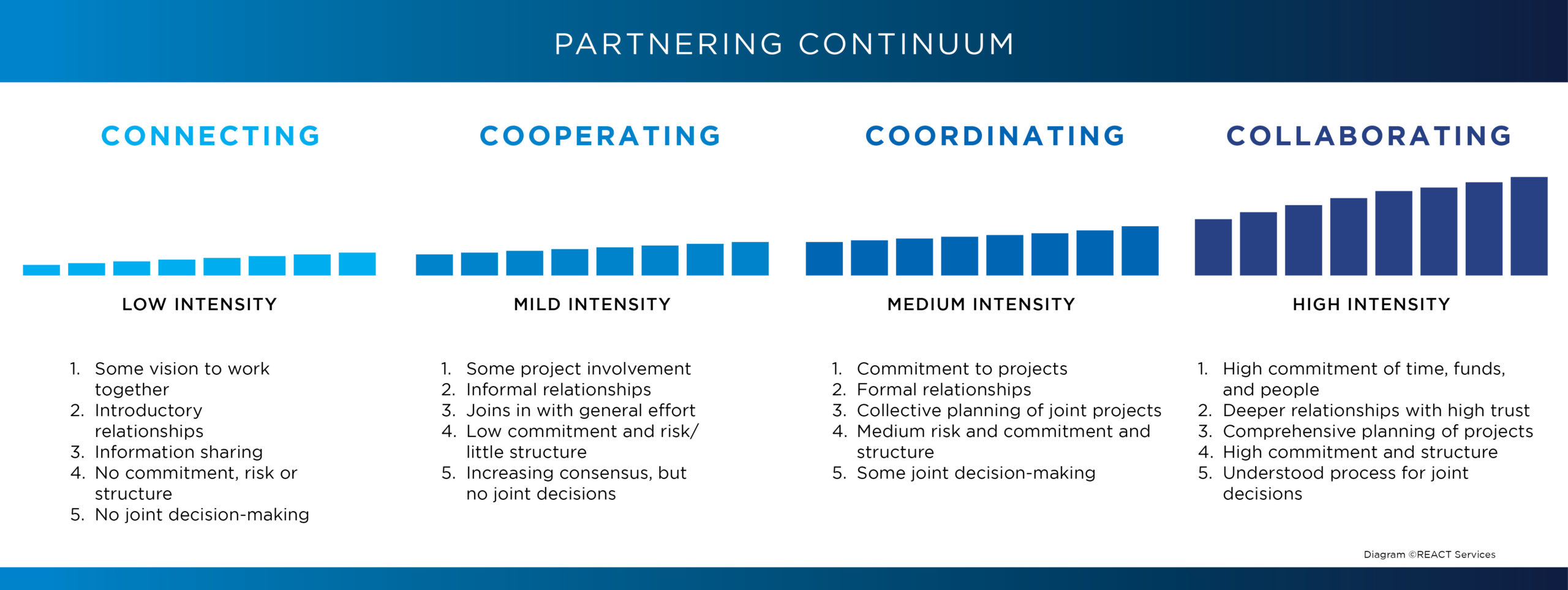By Werner Momberg
If we want to steer the change of a world in rapid shift, we need to learn how to partner well.
Over the last 40 years, Mergon has partnered with a broad range of ministries, primarily working in Africa and the Middle East. As a result, we’ve learnt a lot about what constitutes an effective partnership. Our aim is to walk a journey with our partners in order to support them, help them build capacity, and to see them be as effective in their mission as possible. Though we aren’t done learning, we are convinced that intentional partnerships are paramount in bringing change to a rapidly changing society.
Brain O’Connell is the CEO of REACT Services, an organisation that catalyses, facilitates, and coaches global networks and partnerships in partnering strategies as they work among the most vulnerable and least reached peoples of the world. He explains the purpose of partnership as ‘solving larger problems by bringing to bear multiple resources, improving efficiency, and promoting increased ministry innovation.’*
Essentially, I see four components at play here:
1. Shared focus – ‘solving larger problems’
2. Contribution – ‘bringing to bear multiple resources’
3. Participation – ‘improving efficiency’
4. Creative thinking – ‘increased ministry innovation’
These components align seamlessly with O’Connell’s ‘Partnering Continuum’ diagram – a helpful graphic for understanding how partnering efforts develop through four phases namely CONNECTING, CO-OPERATING, COORDINATING, and COLLABORATING. This diagram has helped us as a resource partner to adopt a big picture view on partnership, understanding the processes required to cultivate fruitful, long-term relationships. In the same breath, it has helped us to recognise that every partnership is unique, rendering a customised level of commitment and unique path to achieve enriching outcomes.

FOUR PHASES OF PARTNERSHIP
For CONNECTING to occur, there needs to be a shared focus (1) which motivates this process of engagement. To identify this particular focus, an organisation firstly needs to contextualise the problem within the larger sphere of transformation. For instance, a concern for the spiritual transformation of youth in a community is intertwined with education and the socio-economic environment of the community. This requires engagement with all the stakeholders in the community with whom different levels of partnership can be considered.
We recognise that not all partnerships will proceed to the fourth stage of long-term collaboration. Nevertheless, every stage of the journey is important to us, especially the initial phase when new relationships and connections are forged along a shared path of Kingdom purpose. During this phase, we are willing to share information, experiences and insights, without necessarily making a formal funding commitment.
Once a process of CONNECTING has taken place, each stakeholder needs to determine the parameters of this envisioned partnership. In the words of O’Connell, what levels of contribution (2) will they commit to, how will they define their participation (3), and where will they further the process of creative thinking (4) to enrich these partnerships?
This obviously varies from partnership to partnership depending on:
– The level of involvement in a project in terms of time, funds and resources.
– The level of relationship and trust in the partnership.
– The level of commitment based on the perceived risk of the partnership or project.
– The level of joint ownership in terms of decision making and planning.
These levels of consideration depend on the organisation’s commitment to address the ‘larger problem’, its willingness to share resources, and its preparedness to develop trust relationships. This is where we move from a process of CONNECTING to CO-OPERATING. This phase allows an organisation to assess the relationship for possible increased levels of engagement. At Mergon, if we realise that the relationship develops and it becomes evident and a higher level of alignment in terms of the shared focus (1) becomes evident, we may allocate some level of discretionary funding to initiate a partnership journey.
As the relationship grows, along with greater levels of commitment to measure the outcomes of our engagement, we may agree to take the partnership to the next level of commitment and contribution.
The continued growth in the relationship may then lead to a COORDINATING phase with an increased commitment to a particular project or initiative, albeit financial, relational or logistical. This allows the team to gain a thorough understanding of the partner organisation’s vision, mission and operations.
In cases where the trust relationship and alignment grow, stakeholders may decide to form a COLLABORATIVE PARTNERSHIP. This means a commitment to a deep relationship with a high level of trust, along with significant levels of resource contributions towards a more long-term funding relationship. The partners may also agree to collaborate closely on a specific strategic initiative, jointly committing to certain resource contributions and outcomes.
Over the years at Mergon, we have found that there is an inextricable link between strategic partnering and overall impact. The development of a partnership engagement strategy is essential for long-term sustainability and relevance. As we strive to create long-lasting, positive impact, let’s lean on the power of partnerships to strengthen our outcomes and bring the desired change.
*Getting Past the Myths of Partnering, Brian O’Connel, Mission Frontiers: Networks are changing the shape of the world, Issue 39:2, March – April 2017, P31-34
All rights reserved. Copyright 2018 Mergon Group.
